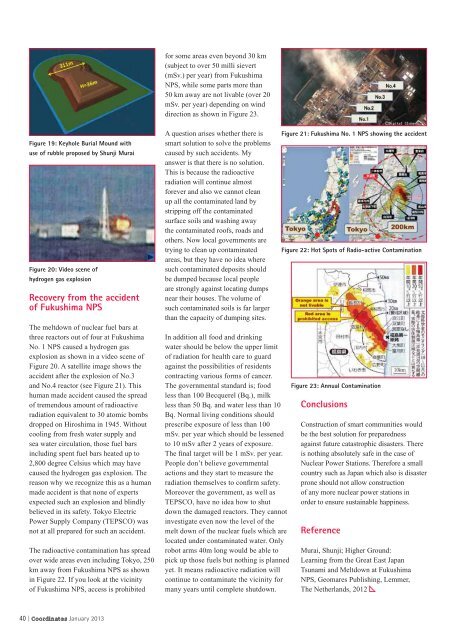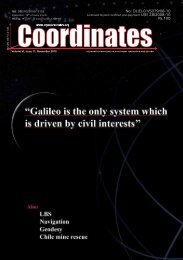Download - Coordinates
Download - Coordinates
Download - Coordinates
You also want an ePaper? Increase the reach of your titles
YUMPU automatically turns print PDFs into web optimized ePapers that Google loves.
Figure 19: Keyhole Burial Mound with<br />
use of rubble proposed by Shunji Murai<br />
Figure 20: Video scene of<br />
hydrogen gas explosion<br />
Recovery from the accident<br />
of Fukushima NPS<br />
The meltdown of nuclear fuel bars at<br />
three reactors out of four at Fukushima<br />
No. 1 NPS caused a hydrogen gas<br />
explosion as shown in a video scene of<br />
Figure 20. A satellite image shows the<br />
accident after the explosion of No.3<br />
and No.4 reactor (see Figure 21). This<br />
human made accident caused the spread<br />
of tremendous amount of radioactive<br />
radiation equivalent to 30 atomic bombs<br />
dropped on Hiroshima in 1945. Without<br />
cooling from fresh water supply and<br />
sea water circulation, those fuel bars<br />
including spent fuel bars heated up to<br />
2,800 degree Celsius which may have<br />
caused the hydrogen gas explosion. The<br />
reason why we recognize this as a human<br />
made accident is that none of experts<br />
expected such an explosion and blindly<br />
believed in its safety. Tokyo Electric<br />
Power Supply Company (TEPSCO) was<br />
not at all prepared for such an accident.<br />
The radioactive contamination has spread<br />
over wide areas even including Tokyo, 250<br />
km away from Fukushima NPS as shown<br />
in Figure 22. If you look at the vicinity<br />
of Fukushima NPS, access is prohibited<br />
40 | <strong>Coordinates</strong> January 2013<br />
for some areas even beyond 30 km<br />
(subject to over 50 milli sievert<br />
(mSv.) per year) from Fukushima<br />
NPS, while some parts more than<br />
50 km away are not livable (over 20<br />
mSv. per year) depending on wind<br />
direction as shown in Figure 23.<br />
A question arises whether there is<br />
smart solution to solve the problems<br />
caused by such accidents. My<br />
answer is that there is no solution.<br />
This is because the radioactive<br />
radiation will continue almost<br />
forever and also we cannot clean<br />
up all the contaminated land by<br />
stripping off the contaminated<br />
surface soils and washing away<br />
the contaminated roofs, roads and<br />
others. Now local governments are<br />
trying to clean up contaminated<br />
areas, but they have no idea where<br />
such contaminated deposits should<br />
be dumped because local people<br />
are strongly against locating dumps<br />
near their houses. The volume of<br />
such contaminated soils is far larger<br />
than the capacity of dumping sites.<br />
In addition all food and drinking<br />
water should be below the upper limit<br />
of radiation for health care to guard<br />
against the possibilities of residents<br />
contracting various forms of cancer.<br />
The governmental standard is; food<br />
less than 100 Becquerel (Bq.), milk<br />
less than 50 Bq. and water less than 10<br />
Bq. Normal living conditions should<br />
prescribe exposure of less than 100<br />
mSv. per year which should be lessened<br />
to 10 mSv after 2 years of exposure.<br />
The fi nal target will be 1 mSv. per year.<br />
People don’t believe governmental<br />
actions and they start to measure the<br />
radiation themselves to confi rm safety.<br />
Moreover the government, as well as<br />
TEPSCO, have no idea how to shut<br />
down the damaged reactors. They cannot<br />
investigate even now the level of the<br />
melt down of the nuclear fuels which are<br />
located under contaminated water. Only<br />
robot arms 40m long would be able to<br />
pick up those fuels but nothing is planned<br />
yet. It means radioactive radiation will<br />
continue to contaminate the vicinity for<br />
many years until complete shutdown.<br />
Figure 21: Fukushima No. 1 NPS showing the accident<br />
Figure 22: Hot Spots of Radio-active Contamination<br />
Figure 23: Annual Contamination<br />
Conclusions<br />
Construction of smart communities would<br />
be the best solution for preparedness<br />
against future catastrophic disasters. There<br />
is nothing absolutely safe in the case of<br />
Nuclear Power Stations. Therefore a small<br />
country such as Japan which also is disaster<br />
prone should not allow construction<br />
of any more nuclear power stations in<br />
order to ensure sustainable happiness.<br />
Reference<br />
Murai, Shunji; Higher Ground:<br />
Learning from the Great East Japan<br />
Tsunami and Meltdown at Fukushima<br />
NPS, Geomares Publishing, Lemmer,<br />
The Netherlands, 2012
















